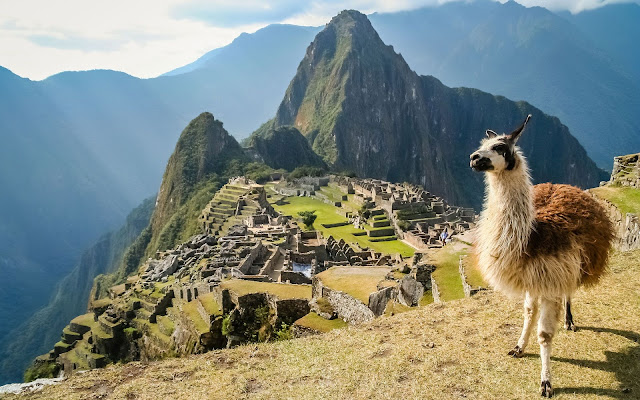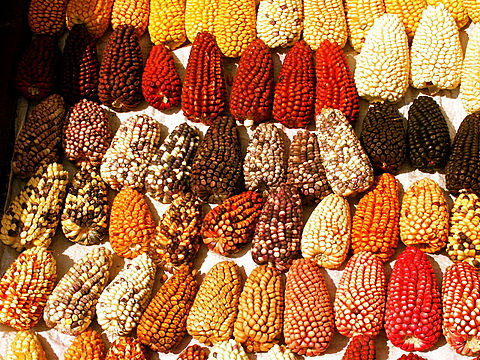Peru is a country in South America, situated on the western side of that continent, facing the South Pacific Ocean and straddling part of the Andes mountain range that runs the length of South America. Peru is bordered by Ecuador and Colombia to the north, Brazil and Bolivia to the east, and Chile to the south. Peru is a country that has a diversity and wealth not common in the world. The main attractions are their archaeological patrimony of pre-Columbian cultures and the hub of the Inca's empire, their gastronomy, their colonial architecture (it has imposing colonial constructions) and their natural resources (a paradise for ecological tourism).
1.Machu Picchu the most famous tourist spot is in Peru
Machu Picchu stands 2,430 m above sea-level, in the middle of a tropical mountain forest, in an extraordinarily beautiful setting. It was probably the most amazing urban creation of the Inca Empire at its height; its giant walls, terraces and ramps seem as if they have been cut naturally in the continuous rock escarpments. The natural setting, on the eastern slopes of the Andes, encompasses the upper Amazon basin with its rich diversity of flora and fauna.
2.Peru is Origin of the Potato
There are over 3,000 different varieties of Potato grown in Peru
The potato, from the perennial Solanum tuberosum, is the world’s fourth largest food crop, following rice, wheat, and maize. The Inca Indians in Peru were the first to cultivate potatoes around 8,000 BC to 5,000 B.C.
In 1536 Spanish Conquistadors conquered Peru, discovered the flavors of the potato, and carried them to Europe
3.Peru has the World's Longest Mountain Range
- The Andes is the longest mountain range in the world and boasts some of the highest peaks. The range is also known for its volcanoes, ruins of long-ago civilizations and the source of a malaria treatment.
- Located along the entire western coast of South America, the Andes mountain range is about 4,500 miles (7,242 kilometers) long. The mountain range spans seven countries — Venezuela, Colombia, Ecuador, Peru, Bolivia, Chile and Argentina — and can be found between 10 degrees north and 57 degrees south latitudes and 70 degrees to 80 degrees west longitude. It is up to 500 miles (804 km) wide.
- The only mountains that are taller than the Andes are the Himalaya Mountains and their adjacent ranges, including the Hindu Kush. The average elevation in the Andes is about 13,000 feet (3,962 meters). The highest elevation in the Andes is Mount Aconcagua in Argentina, which is 22,841 feet (6,962 m) above sea level.
4.Forget the Sahara Desert, Peru actually has the highest sand dune in the World!
Cerro Blanco sand dune, located in the Sechura Desert in the south of Peru, measures 3,860 feet from the base to the summit. It towers over the quaint desert oasis town, Huacachina, and the best part of all is that you can ride dune buggies for hours and up to the top of the dunes and then strap a board to your feet and sand board down it all the way to the town below!
5. The Largest Flying Bird on Earth can be found in Peru, The Giant Andean Condor
- The Andean condor is a national symbol of peru.
- With a wingspan of over 3 meters (10 feet), the Andean Condor is considered the largest flying bird in the world. Fully grown adults can reach a whopping 15 kg (33 pounds) and can stand an impressive 1.2 meters tall. This stunning creature is the largest Raptor in the entire world.
- Today, one of the best places to see the Andean condor is the semi-arid Colca Canyon, a marvel twice as deep as the Grand Canyon located about 100 miles (160 kilometers) north of Arequipa, Peru's second largest city
One of the most widely-consumed foodstuffs in Peruvian cuisine. This corn has been planted in Peru since at least 1200 BC. The ancient Peruvian farmers achieved a degree of sophistication in the selection and creation of new varieties which adapted to varying terrains and climates.
Sixteenth-century Spanish chronicler "Bernabé Cobo" wrote how in ancient Peru one could find corn (known locally as choclo) in every color under the sun: white, yellow, purple, black, red and mixed. Today, farmers along the Peruvian coast, highlands and jungle grow more than 55 varieties of corn, more than anywhere else on Earth.
7. Peru has the second largest amount of Shamans in the world
Shamanism has been popular in Peru for over 3,000 years. Since most of the Peruvian population cannot afford or don’t have access to doctors or Western medical care, many people, especially natives, turn to a shaman’s healing art, or curandero, a rural spiritual healer. Most shamans use hallucinogenic drugs, such as ayahuasca in their healing.
8.Gold Mining in Peru
- Peru is currently ranked as the 6th largest gold producer in the world. This is very significant when you consider than it is much smaller in landmass than most of the countries that rank above it. The Andes Mountains have some of the richest gold deposits in the world.
- The Yanacocha Gold Mine is operated by the Newmont Mining Corporation in Northern Peru. It is the second largest open pit gold mine in the world, and has produced over $7 billion dollars’ worth of gold.
- Peru is now making one of the most expensive coffees in the world by picking arabica beans out of the dung of a long-nosed jungle critter called the coati, a tropical cousin of the raccoon. Chanchamayo Highland Coffee, is the second Peruvian venture to copy a rare technique that harnesses a mammal’s digestive tract to strip bitter-tasting proteins from coffee beans. After the creatures eat ripe coffee cherries, the growers wash, roast and export the beans that emerge partially fermented, but whole, in the animals’ scat.
- In doing so, the Peruvians are catering to the whims of global coffee consumers willing to pay anywhere from $20 to $65 for a cup of the odd treat!
- Peru’s is the 8th largest producer of coffee in the world, and is the 5th largest producer of the Arabica bean.
- There are 90 different micro-climates in Peru
- Peru is a country of varied climate. Coast, Desert, Mountain, Jungle. Because of the influence of the cold Peruvian Oceanic Flow there is a dramatic change from the near-coast desert climate to the inland tropical valleys and then the high mountains of the Andes Range.
- Peru counts among the 10 most biologically diverse countries in the world. It is home to 25,000 plant species (10% of the world’s total) and close to 5,000 species of fish and animals. It ranks first in the world in terms of distinct fish species, second for birds, and third place for both amphibians and mammals. In fact, the Manu National Park in south eastern Peru recently set a biodiversity record after more than 1,000 species of birds, 1,200 species of butterflies and 287 species of reptiles were found in the park.
Quotes About Peru
Going to Peru is, well, if you ever have an opportunity in your life to go there, you should do it because it is absolutely mind boggling – Dean Stockwell, actor













No comments:
Post a Comment